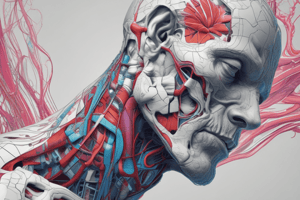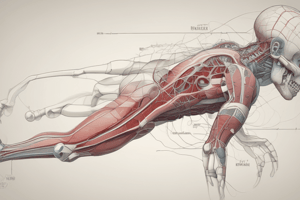Podcast
Questions and Answers
The epidermis is the innermost layer of the skin.
The epidermis is the innermost layer of the skin.
False (B)
The dermis is composed of stratified squamous epithelium.
The dermis is composed of stratified squamous epithelium.
False (B)
Sweat glands produce sebum, an oily substance that helps to moisturize the skin.
Sweat glands produce sebum, an oily substance that helps to moisturize the skin.
False (B)
The skin's barrier function prevents water loss and entry of pathogens.
The skin's barrier function prevents water loss and entry of pathogens.
The hypodermis is responsible for providing strength and elasticity to the skin.
The hypodermis is responsible for providing strength and elasticity to the skin.
Nail plates are composed of live keratin cells.
Nail plates are composed of live keratin cells.
Study Notes
Layers of the Skin
The skin is composed of three main layers:
- Epidermis: The outermost layer, responsible for protecting the body from external factors such as water loss, UV radiation, and infection.
- Thickness: 0.05-1.5 mm
- Composed of stratified squamous epithelium, melanocytes, Langerhans cells, and Merkel cells
- Dermis: The middle layer, responsible for providing strength, elasticity, and nourishment to the skin.
- Thickness: 1-4 mm
- Composed of connective tissue, blood vessels, nerve endings, and hair follicles
- Hypodermis: The innermost layer, responsible for attaching the skin to underlying tissues and storing energy.
- Thickness: 1-4 cm
- Composed of subcutaneous fat, connective tissue, and adipose tissue
Skin Appendages
- Hair follicles: Produces hair, anchored to the dermis by a sebaceous gland
- Sweat glands: Produces sweat, regulated by the nervous system
- Sebaceous glands: Produces sebum, an oily substance that helps to moisturize the skin
- Nail plates: Composed of dead keratin cells, grows from the nail matrix
Skin Functions
- Barrier function: Prevents water loss and entry of pathogens
- Thermoregulation: Regulates body temperature through sweating and vasodilation
- Sensation: Detects and transmits sensory information to the brain
- Immune function: Provides an immune response to pathogens and foreign substances
- Wound healing: Initiates and coordinates the wound healing process
Layers of the Skin
- Epidermis is the outermost layer, 0.05-1.5 mm thick, responsible for protecting the body from external factors like water loss, UV radiation, and infection.
- It is composed of stratified squamous epithelium, melanocytes, Langerhans cells, and Merkel cells.
- Dermis is the middle layer, 1-4 mm thick, providing strength, elasticity, and nourishment to the skin.
- It is composed of connective tissue, blood vessels, nerve endings, and hair follicles.
- Hypodermis is the innermost layer, 1-4 cm thick, attaching the skin to underlying tissues and storing energy.
- It is composed of subcutaneous fat, connective tissue, and adipose tissue.
Skin Appendages
- Hair follicles produce hair, anchored to the dermis by a sebaceous gland.
- Sweat glands produce sweat, regulated by the nervous system.
- Sebaceous glands produce sebum, an oily substance that helps to moisturize the skin.
- Nail plates are composed of dead keratin cells, growing from the nail matrix.
Skin Functions
- The skin's barrier function prevents water loss and entry of pathogens.
- Thermoregulation regulates body temperature through sweating and vasodilation.
- The skin detects and transmits sensory information to the brain through sensation.
- The skin provides an immune response to pathogens and foreign substances through immune function.
- The skin initiates and coordinates the wound healing process through wound healing.
Studying That Suits You
Use AI to generate personalized quizzes and flashcards to suit your learning preferences.
Description
Learn about the three main layers of the skin, including the epidermis and dermis, and their functions and compositions.




